 Designers of DAB radios seem a strange lot.
Designers of DAB radios seem a strange lot.
Although the technology may be 21st century, DAB radios have often ended up looking like they’ve been teleported in from a previous age.
Perhaps charged with a mission to lure pipe-smoking Terry Wogan addicts into the wonderful digital age, there’s been a long string of DAB products cased in reassuringly old fashioned Ye Olde Wooden Panels or leatherette surrounds.
There’s been DAB radios harking back to an even earlier vintage too, with manufacturers like Roberts creating designs that wouldn’t look out of a place in a 1940s living room.
Whenever designers have taken it upon themselves to create something that looks vaguely modern, they tend to go to the other extreme, creating curious scary sci-fi creations that would send granny’s zimmerframe into overdrive.
DAB radios have also tended to come in just two sizes: big and bulky for carting around the house/garden or teensy weensy for the pockets of joggers and subway riders, with precious little inbetween.
 Sensing a gap in the market, leading UK DAB manufacturer Pure have come up with the Pure Move.
Sensing a gap in the market, leading UK DAB manufacturer Pure have come up with the Pure Move.
Offering clean simple lines with more than a nod towards the great transistor age of the 60s, the Move is an attractive compact portable, measuring in at 150 mm x 85 mm x 27 mm.
Look and feel
Substantially built, the 280g Move looks like it could handle a few knocks, with a metal finish on the front and rubberised material on the side and back giving a good grip.
A small kick stand folds out of the back offering a good viewing angle of the display, with an extending aerial helping reinforce its traditional tranny radio look.
We weren’t quite so impressed with the power on button, though. This sits on the side of the radio and has to be held in for several seconds before the radio will turn on or off. A simple switch would have been far preferable.
On powering up for the first time, the display glows orange and the radio scans for all available stations, a process that took around a minute.
Using the front mounted controls, it was easy to navigate to a station of our choice (BBC6 Radio please!) and we were impressed by both the sound quality and volume of the unit.
 Obviously, bass heads aren’t going to get their denture rattling fix from something as diminutive as this fella, but the sound quality was punchy and pleasing enough for everyday use.
Obviously, bass heads aren’t going to get their denture rattling fix from something as diminutive as this fella, but the sound quality was punchy and pleasing enough for everyday use.
Controlling the Move
Using the Move was pretty simple too, with the central circular controller letting you swiftly adjust the volume up/down and flip through radio stations.
Either side of the controller are Info/Preset and Menu/Dab/FM switches and – as with most Pure products – the interface was simple and intuitive.
Up to 10 DAB and 10 FM presets can be stored and the preset order arranged to your liking.
The Info button cycles the information displayed on the 2-line LCD screen, giving current date / time, station genre, multiplex, frequency, bit rate, signal strength and, most usefully, a single scrolling line of song info/news snippets.
The menu key gives access to EQ settings, display controls and firmware upgrades, with a hold key ensuring that no clumsy oaf changes the station by mistake.
Connections
Apart from the mains in socket, the Move comes equipped with a mini USB jack, aux in and a headphone jack.
Powered by their ChargePak technology, Pure’s internal rechargeable cell (Li-ion 4200 mAh) nearly managed to match the claimed highly impressive 40 hours of listening time, although we reckon most people will just keep it plugged in anway.
Reception on both DAB and FM was great with the aerial extended or packed away – not surprising seeing as we can see the Crystal Palace transmitter from our window – but we weren’t able to test coverage in less well served areas.
 Conclusion
Conclusion
With its extended battery life, simple controls and traditional looks, Pure have come up with a very attractive offering which deserves to do well.
The asking price of £90 is a tad steep, but consumers looking for a versatile DAB radio that is truly portable may find it an excellent investment. We liked it.
The verdict
Features: 87%
Ease of Use: 85%
Build Quality: 85%
Overall: 86%
Specifications:
Palm-sized DAB and FM radio with full DAB Band III reception.
Frequency range: DAB Band III 174-240 MHz, FM 87.5-108 MHz.
Input connectors: 5V DC power adaptor socket (230V supplied), 3.5 mm Aux-in, and Mini USB connector for software upgrades.
Output connectors: 3.5 mm stereo headphone output.
Controls: Power, Lock, Info, Preset, Navigator, DAB/FM and Menu.
Presets: 10 DAB and 10 FM. LCD display: Orange backlit LCD display with 16 x 2 characters, function icons (volume, battery life, time, EQ, signal strength, DAB/FM and stereo) and clock. Key-press activated backlight can also be set to ‘always on’ for optimum visibility or ‘always off’ for longer battery life.
Mains Power supply: 230V AC to 5V (0.6A) DC external power adapter.
Battery Power supply: ChargePAK-inside Li-ion 4200 mAh rechargeable battery provides over 40 hours of portable DAB listening.
Dimensions: 150 mm wide x 85 mm tall x 27 mm deep. Weight: 280g
Aerial: Recessed telescopic aerial supplied. Headphones act as an aerial when connected. (Headphones not supplied.)
Pure
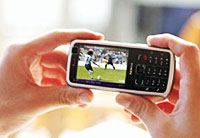 Nordic big-knobs Nokia have knocked out another two handsets for your delectation today.
Nordic big-knobs Nokia have knocked out another two handsets for your delectation today.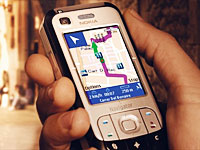 Lurking on the back is a 2 megapixel camera, with the N77 delivering on the multimedia front, offering visual radio and support for MP3, AAC, AAC+, eAAC+ and WMA media.
Lurking on the back is a 2 megapixel camera, with the N77 delivering on the multimedia front, offering visual radio and support for MP3, AAC, AAC+, eAAC+ and WMA media.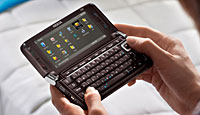 Nokia E90 Communicator
Nokia E90 Communicator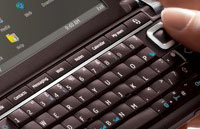 There’s also integrated GPS and Nokia Maps wedged into the chunky handset, but all those features are going to come at a wallet-whipping price, with the E90 expected to be priced at around a stratospheric €750.
There’s also integrated GPS and Nokia Maps wedged into the chunky handset, but all those features are going to come at a wallet-whipping price, with the E90 expected to be priced at around a stratospheric €750. We reckon there could be moist spots breaking out in the gussets of mobile phone freaks everywhere with a veritable onslaught of new phones being announced today.
We reckon there could be moist spots breaking out in the gussets of mobile phone freaks everywhere with a veritable onslaught of new phones being announced today.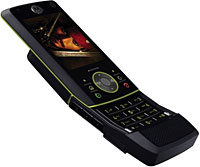 Decked out in a natty black body with green trim, the MOTORIZR Z8 features a 1.4 x 2-inch, QVGA 16 million colour display and a twin camera set up, with a 2 megapixel camera on the back (with 8x zoom and lumi LED light) and a lower spec’d VGA jobbie up front for video calls.
Decked out in a natty black body with green trim, the MOTORIZR Z8 features a 1.4 x 2-inch, QVGA 16 million colour display and a twin camera set up, with a 2 megapixel camera on the back (with 8x zoom and lumi LED light) and a lower spec’d VGA jobbie up front for video calls.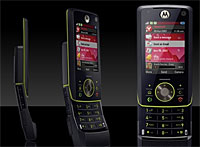 There’s also A2DP stereo Bluetooth audio onboard, support for SMS, EMS, MMS 1.22 messaging and SMTP, POP3, IMAP4, SSL/TLS2 email.
There’s also A2DP stereo Bluetooth audio onboard, support for SMS, EMS, MMS 1.22 messaging and SMTP, POP3, IMAP4, SSL/TLS2 email.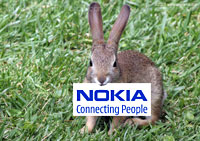 Nokia, the undisputed heavyweight champs of the mobile phone world, have taken the wraps off their new 6110 Navigator smartphone.
Nokia, the undisputed heavyweight champs of the mobile phone world, have taken the wraps off their new 6110 Navigator smartphone. According to Nokia, they will be offering the smart2go on Nokia S60 and Windows Mobile 5.0 devices, and then rolling out support for most of the major mobile OS platforms including Nokia S60/S40, PocketPC, Linux and other Windows Mobile devices.
According to Nokia, they will be offering the smart2go on Nokia S60 and Windows Mobile 5.0 devices, and then rolling out support for most of the major mobile OS platforms including Nokia S60/S40, PocketPC, Linux and other Windows Mobile devices.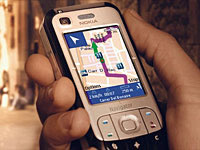 UPDATE: Image through now …. der dah!
UPDATE: Image through now …. der dah!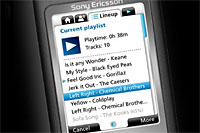 You may not have heard of them yet, but feisty Brit mobile music company Omnifone have announced one of the first big challengers to Apple’s soon-come iPhone/iTunes Store service.
You may not have heard of them yet, but feisty Brit mobile music company Omnifone have announced one of the first big challengers to Apple’s soon-come iPhone/iTunes Store service. “We will ensure the vast majority of Europeans have the freedom to choose MusicStation by the time iPhone arrives in Europe. We will give consumers the choice they deserve,” he added.
“We will ensure the vast majority of Europeans have the freedom to choose MusicStation by the time iPhone arrives in Europe. We will give consumers the choice they deserve,” he added.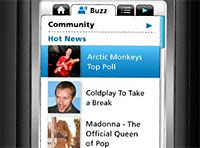 Predictably, music tracks will come with digital rights management and be delivered in the eAAC+ format (that’s enhanced advanced audio coding, in case you’re into knowing that kind of thing).
Predictably, music tracks will come with digital rights management and be delivered in the eAAC+ format (that’s enhanced advanced audio coding, in case you’re into knowing that kind of thing).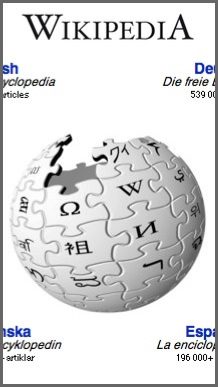 Whilst there have been sensationalist reports that Wikipedia would be forced to close in three to four months if the current financial situation continued, this has shown not to be the case by
Whilst there have been sensationalist reports that Wikipedia would be forced to close in three to four months if the current financial situation continued, this has shown not to be the case by 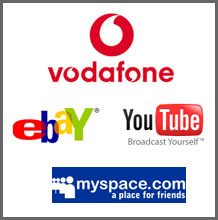 We thought it would be worthwhile taking a look as to why this might be happening and why it’s come at this time.
We thought it would be worthwhile taking a look as to why this might be happening and why it’s come at this time.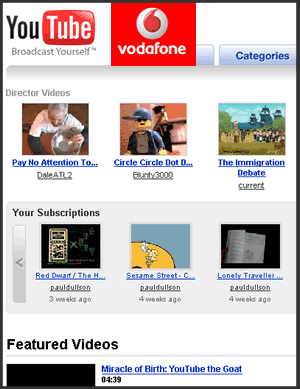 Is this now getting boring? Vodafone have announced another content access deal, this time with YouTube.
Is this now getting boring? Vodafone have announced another content access deal, this time with YouTube. Currently Vodafone have a bigger network than Orange, so Orange would gain more than Vodafone from the deal, but in future it means that new cell sites will be used by both operators.
Currently Vodafone have a bigger network than Orange, so Orange would gain more than Vodafone from the deal, but in future it means that new cell sites will be used by both operators. Why the rush to build?
Why the rush to build?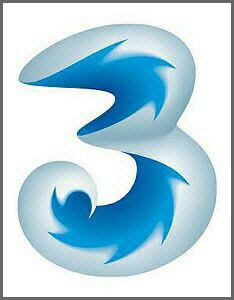 Though city centres might have a demand for 3G (for data services, no one cares about 3G voice – a voice call sounds the same whether it’s 3G or GSM), as you leave dense urban areas the appeal of 3G is less. Well maybe not less, but there are less people to use it and less of a reason for the networks to install 3G infrastructure and sites.
Though city centres might have a demand for 3G (for data services, no one cares about 3G voice – a voice call sounds the same whether it’s 3G or GSM), as you leave dense urban areas the appeal of 3G is less. Well maybe not less, but there are less people to use it and less of a reason for the networks to install 3G infrastructure and sites.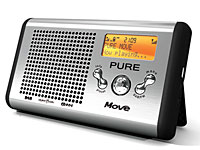 Designers of DAB radios seem a strange lot.
Designers of DAB radios seem a strange lot.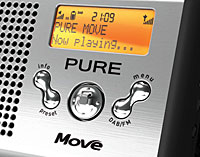 Sensing a gap in the market, leading UK DAB manufacturer Pure have come up with the Pure Move.
Sensing a gap in the market, leading UK DAB manufacturer Pure have come up with the Pure Move.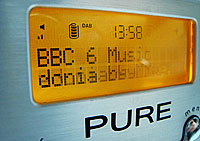 Obviously, bass heads aren’t going to get their denture rattling fix from something as diminutive as this fella, but the sound quality was punchy and pleasing enough for everyday use.
Obviously, bass heads aren’t going to get their denture rattling fix from something as diminutive as this fella, but the sound quality was punchy and pleasing enough for everyday use. Conclusion
Conclusion